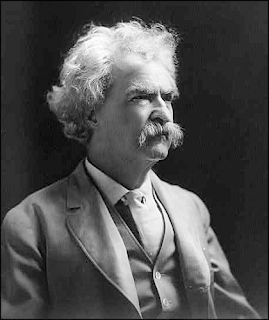Mark Twain: Who Laughs to Hide His Despair of Human Condition
Mark Twain (Real Name: Samuel Langhorne Clemens (1835 –1910) is a renowned American author, humorist, and lecturer, whose works have left an indelible mark on American literature. He is widely known for his witty humor, satire, and his sharp social commentary. However, beneath the surface of his humor, lies a darker side that often reveals the harsh reality of human existence. Louis Untermeyer, an American poet and anthologist, once commented that Mark Twain was not only a prime jokester but also a traditional clown who laughs to hide his despair of human condition. This essay aims to examine the relevance of Untermeyer's comment in light of Mark Twain's life and works.
"The Adventures of Huckleberry Finn" and Dark Humor
 |
| Mark Twain |
Through ironic situations, biting satire, and clever wit, Twain tackles sensitive issues such as racism, hypocrisy, and societal corruption. This dark humor serves to expose the flaws of society while simultaneously provoking introspection and critical thinking in readers. One notable example of dark humor occurs when Huck Finn encounters two con artists, the Duke and the King. Despite their devious nature, the townspeople readily believe their outlandish lies and enthusiastically support their fraudulent schemes. Twain uses this humorous situation to highlight the gullibility and foolishness of society, satirizing the blind acceptance of false authority and shedding light on the inherent flaws within human nature.
"The Lowest Anima": Twain's use of Humor to Highlight the Brutal and Savage Nature of Human Beings
Twain's Humor at Literary Pretensions of His Contemporaries
Twain's humor, often laced with sarcasm and irony, reflects his deep-seated disillusionment with the world and its inhabitants. In his works, he exposes the flaws and follies of human beings, and the absurdity of their actions.
For example, in his essay "Fenimore Cooper's Literary Offenses," Twain satirizes James Fenimore Cooper's novels, highlighting the author's lack of literary skill and his reliance on cliches and stereotypes. By doing so, Twain not only criticizes Cooper but also exposes the literary pretensions of his contemporaries. Twain continues to demonstrate his dark humor and biting wit. He relentlessly mocks Cooper's writing style, pointing out repetitive plot devices, wooden characters, and unrealistic situations. Twain's scathing critique not only targets Cooper but also serves as a broader commentary on the state of literature during his time. By highlighting the shortcomings of a popular author, Twain challenges the prevailing literary norms and encourages readers to question the quality and originality of the works they consume. His dark humor cuts through the literary pretensions of his contemporaries, inviting a critical examination of the literary landscape and a reevaluation of what constitutes truly exceptional writing:
"It seems to me that it was far from right for the Professor of English Literature at Yale, the Professor of English Literature in Columbia, and Wilkie Collins to deliver opinions on Cooper's literature without having read some of it. It would have been much more decorous to keep silent and let persons talk who have read Cooper.
Cooper's art has some defects. In one place in "Deerslayer," and in the restricted space of two-thirds of a page, Cooper has scored 114 offenses against literary art out of a possible 115. It breaks the record."
Conclusion:
In conclusion, Louis Untermeyer's comment that Mark Twain was not only a prime jokester but also a traditional clown who laughs to hide his despair of human condition, is a relevant observation that captures the essence of Twain's works. Twain's dual persona, as revealed in his works, reflects his profound understanding of the human condition and his disillusionment with the world. His humor, often used to expose the flaws and follies of human beings, remains a powerful tool for social commentary even today. As a student of literature, we can learn much from Twain's works and use his approach to humor as a means of social commentary and criticism.
Reference
2. The Project Gutenberg eBook of Adventures of Huckleberry Finn, By Mark Twain. (n.d.). The Project Gutenberg eBook of Adventures of Huckleberry Finn, by Mark Twain. https://www.gutenberg.org/files/76/76-h/76-h.htm
3. The Lowest Animal. (n.d.). The Lowest Animal. http://www.la.utexas.edu/users/bump/The%20Lowest%20Animal.htm
4. Fenimore Cooper’s Literary Offenses. (n.d.). Fenimore Cooper’s Literary Offenses. https://twain.lib.virginia.edu/projects/rissetto/offense.html

Comments
Post a Comment
Drop any query, suggestion or comment here.